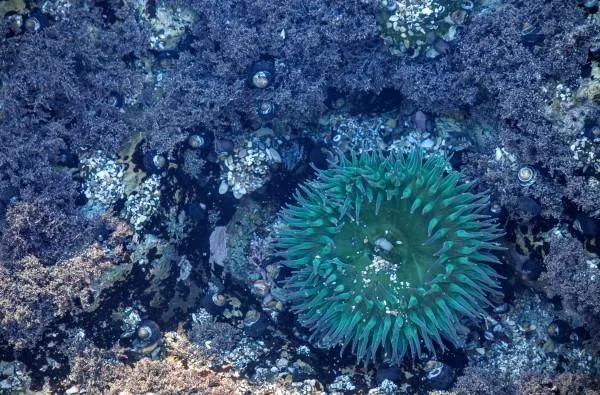Explore beaches in the British isles and you’ll see rockpools of varying sizes with a whole host of rockpool wildlife to identify.
When the tide slips away from the shore, a hidden world appears along the British coastline. From colourful sea anemones to darting shrimps, rockpool wildlife in the UK is full of fascinating creatures waiting to be discovered.
At OA Surf Club in Widemouth Bay, we love introducing visitors of all ages to these miniature marine habitats. Whether you’re a keen naturalist or simply curious to see what lives between the rocks, exploring rockpool wildlife is a brilliant way to connect with nature and enjoy the fresh sea air.
In this guide, you’ll learn what to look for, how to explore safely, and why Widemouth Bay is one of the best places in Cornwall to experience rockpool wildlife up close.
Common Mussel
The common mussel is an edible bivalve mollusc, easily recognised by its smooth blue or purple shell. It thrives along coastlines around the world, clinging to rocks and forming dense clusters near the shore.
Common Blenny / Shanny
If you peer into rockpools around the UK, you might spot the common blenny, also known as the shanny. These small bottom-dwelling fish are masters of disguise, often changing colour to blend perfectly with seaweed and rocks, making them tricky to see at first glance.

Common Limpet
The common limpet moves slowly across rocks on a trail of mucus, feeding on algae as it goes. It uses its tongue, which contains the strongest known biological material in the world, to scrape food and to anchor itself firmly to the surface, even in rough seas.
Common Prawn
The common prawn is easy to recognise by its see-through body marked with brown tiger-like stripes along its back. It has two small claws on its front legs and three pairs of walking legs. As a bottom feeder, the prawn helps keep rockpools clean by eating decaying matter such as dead mussels, seaweed, and other organic debris.

Grey Sea Slug
Image Courtesy of Bude Marine Group
A type of nudibranch, the grey sea slug is commonly found around the British Isles. It feeds on seaweed, sea anemones, and even other nudibranchs. You can recognise it by the soft, feathery plumes along its back, which it uses for breathing.
Dog Whelk
The dog whelk is easy to spot thanks to its pointed, conical shell, which ranges in colour from brown to yellow. These predatory sea snails feed on mussels and barnacles by drilling through their shells and releasing enzymes that break down the soft tissue inside.
Shore Crab
The shore crab is the most common crab you’ll find along UK coasts. It comes in green, red, or orange, and you can recognise it by the pattern of small spikes on its shell.
Shore crabs often hide under rocks and among seaweed. They are scavengers and will eat almost anything they find in the rockpool, from dead animals to bits of seaweed.
Hermit Crab
Hermit crabs don’t grow their own shells. Instead, they find and move into empty mollusc shells to protect their soft bodies.
Like shore crabs, hermit crabs are scavengers. They will eat almost anything they come across, including dead animals, algae, and leftover food.
Common Starfish
The common starfish is usually orangey-yellow and covered in lots of small, bumpy tubes that help it move and hold its food.
Although it is blind, it uses its strong arms to pull cockles and whelks off rocks as it slowly explores the rockpools.
To eat, the starfish holds onto the shell and pushes its stomach out through its mouth and into the shell to digest the soft flesh inside.

Beadlet Anemone
Beadlet anemones look like small blobs of jelly and come in red, orange, or brown.
When they are underwater, they open their tentacles to sting and catch passing prey such as small fish and shrimp.

Snakelock Anemone
Image Courtesy of Bude Marine Group
Unlike the beadlet anemone, the snakelocks anemone cannot pull in its tentacles, so it usually lives lower down the shore where it stays underwater.
Its stinging cells are strong enough to be felt on human skin, so take care when rockpooling near them.
The tentacles are bright green with purple tips. The green colour comes from algae living inside the anemone’s tissues.
Our Local Beach
Here at OA Surf Club, we’re lucky to have our own private beach right on our doorstep.
When the tide goes out, Wanson Beach becomes the perfect place for rockpooling. The reef creates a rich habitat full of sea creatures, all just a short walk from our OA Stay B&B.
On rare occasions, even octopus have been spotted resting in the shallow pools. Most of the rockpool wildlife can be found hidden among the rocks and seaweed, waiting to be discovered.







